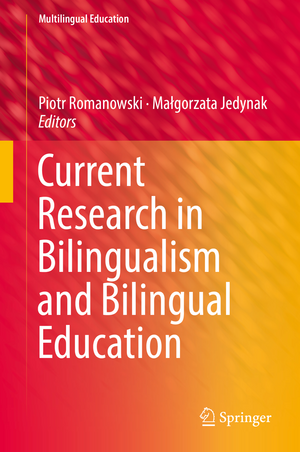Current Research in Bilingualism and Bilingual Education: Multilingual Education, cartea 26
Editat de Piotr Romanowski, Małgorzata Jedynaken Limba Engleză Hardback – 3 aug 2018
| Toate formatele și edițiile | Preț | Express |
|---|---|---|
| Paperback (1) | 942.94 lei 43-57 zile | |
| Springer International Publishing – 9 feb 2019 | 942.94 lei 43-57 zile | |
| Hardback (1) | 948.92 lei 43-57 zile | |
| Springer International Publishing – 3 aug 2018 | 948.92 lei 43-57 zile |
Din seria Multilingual Education
- 18%
 Preț: 902.36 lei
Preț: 902.36 lei - 18%
 Preț: 956.81 lei
Preț: 956.81 lei - 18%
 Preț: 953.65 lei
Preț: 953.65 lei - 18%
 Preț: 836.29 lei
Preț: 836.29 lei - 15%
 Preț: 638.24 lei
Preț: 638.24 lei - 20%
 Preț: 567.32 lei
Preț: 567.32 lei - 20%
 Preț: 566.76 lei
Preț: 566.76 lei - 20%
 Preț: 569.86 lei
Preț: 569.86 lei - 15%
 Preț: 649.87 lei
Preț: 649.87 lei - 15%
 Preț: 645.28 lei
Preț: 645.28 lei -
 Preț: 394.87 lei
Preț: 394.87 lei - 15%
 Preț: 643.84 lei
Preț: 643.84 lei - 15%
 Preț: 643.34 lei
Preț: 643.34 lei -
 Preț: 389.49 lei
Preț: 389.49 lei - 15%
 Preț: 704.36 lei
Preț: 704.36 lei - 20%
 Preț: 555.53 lei
Preț: 555.53 lei - 18%
 Preț: 953.65 lei
Preț: 953.65 lei - 18%
 Preț: 952.26 lei
Preț: 952.26 lei - 15%
 Preț: 646.43 lei
Preț: 646.43 lei - 15%
 Preț: 585.40 lei
Preț: 585.40 lei - 18%
 Preț: 787.15 lei
Preț: 787.15 lei - 18%
 Preț: 1009.22 lei
Preț: 1009.22 lei - 15%
 Preț: 649.22 lei
Preț: 649.22 lei - 18%
 Preț: 1113.39 lei
Preț: 1113.39 lei - 15%
 Preț: 644.95 lei
Preț: 644.95 lei - 15%
 Preț: 634.68 lei
Preț: 634.68 lei - 15%
 Preț: 644.63 lei
Preț: 644.63 lei -
 Preț: 388.90 lei
Preț: 388.90 lei - 15%
 Preț: 647.27 lei
Preț: 647.27 lei - 15%
 Preț: 641.85 lei
Preț: 641.85 lei - 15%
 Preț: 635.80 lei
Preț: 635.80 lei
Preț: 948.92 lei
Preț vechi: 1157.22 lei
-18% Nou
Puncte Express: 1423
Preț estimativ în valută:
181.63€ • 197.36$ • 152.67£
181.63€ • 197.36$ • 152.67£
Carte tipărită la comandă
Livrare economică 21 aprilie-05 mai
Preluare comenzi: 021 569.72.76
Specificații
ISBN-13: 9783319923956
ISBN-10: 3319923951
Pagini: 230
Ilustrații: XIX, 241 p. 31 illus.
Dimensiuni: 155 x 235 mm
Greutate: 0.54 kg
Ediția:1st ed. 2018
Editura: Springer International Publishing
Colecția Springer
Seria Multilingual Education
Locul publicării:Cham, Switzerland
ISBN-10: 3319923951
Pagini: 230
Ilustrații: XIX, 241 p. 31 illus.
Dimensiuni: 155 x 235 mm
Greutate: 0.54 kg
Ediția:1st ed. 2018
Editura: Springer International Publishing
Colecția Springer
Seria Multilingual Education
Locul publicării:Cham, Switzerland
Cuprins
Introduction.- Part I: LANGUAGE ACQUISITION AND LINGUISTIC ASPECTS OF BILINGUALISM.- Strategies of communication in an NNB family – on the way to bilingual maintenance in a monolingual context – Piotr Romanowski.- Is there a relationship between language competences and metalinguistic awareness? – Zofia Chłopek.- Two grammars in the input – two different strategies to process the input. The usage-based perspective on the development of nominal inflection in a bilingual child – Dorota Gaskins.- Codeswitching in French as foreign language classes in Malta: Implications for learning – Anne-Marie Bezzina & Joanne Gauci.- Understanding linguistic features of Estonian-Latvian bilingual speech – Anna Verschik & Elīna Bone.- Part II: LANGUAGE TEACHING ASPECTS OF BILINGUALISM.- Learning fractions through two languages in an elementary classroom: the interrelation of Maltese and English with the mathematics register(s) – Marie Therese Farrugia.- Are classroom requestssimilar in all EFL settings? Focusing on a young multilingual learning environment – Pilar Safont.- Teaching English in a multilingual classroom: Addressing challenges through teacher education and development – Daniel Xerri.- Bilingualism with English as a “second language” and/or broad plurilingual repertoires: A Swiss point of view – Georges Lüdi.- Part III: LANGUAGE EDUCATION ASPECTS OF BILINGUALISM.- Stop the deficit: Preparing pre-service teachers to work with bilingual students in the United States – Johanna Ennser-Kananen & Christine Montecillo Leider.- Discursive techniques in heritage language education – Corinne A. Seals.- The evolution of bilingual education in monolingual settings: An Andalusian case study – María Luisa Pérez Cañado.
Textul de pe ultima copertă
This book covers research topics in bilingual education, language policies, language contact, identity of bilingual speakers, early bilingualism, heritage languages, and more, and provides an overview of current theory, research and practice in the field of bilingualism. Each chapter is written by a specialist in the field. Part I focuses on the numerous and heterogeneous relations between languages as well as the implications arising from bilingual speech processing. In Part II, a series of contextualized studies on bilingual classrooms are presented, with diverse research designs applied in different educational settings being a key feature of these studies. Part III bridges theory and practice by offering an insight into mono- and multilingual school settings showcasing examples of educational institutions where bilingualism successfully soared and depicts the needs related to language education.
Caracteristici
Brings studies by specialists in the field, covering theory, policy and practice Includes studies from various countries and continents Offers insights on all aspects of bilingualism from language acquisition, to teaching and learning
